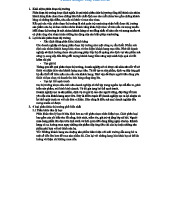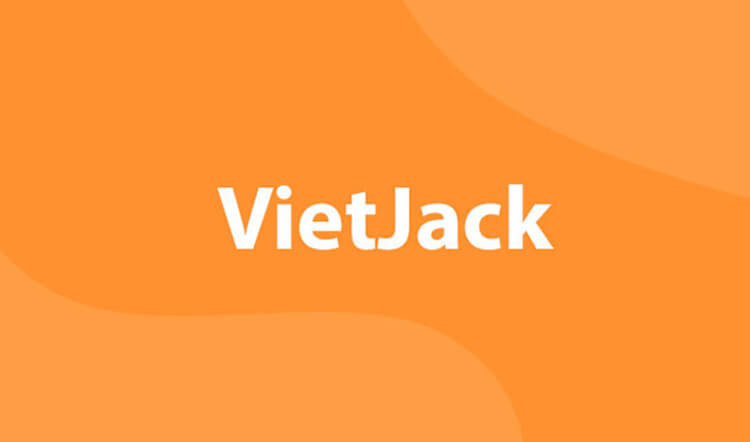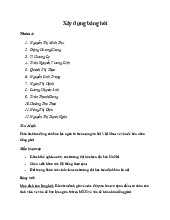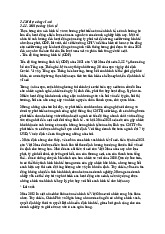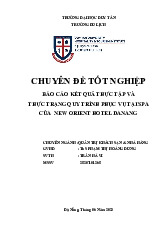



















Preview text:
lOMoAR cPSD| 46831624 ACTIVITY REPORT Company? 2021-2022 Name of the student lOMoAR cPSD| 46831624 ACTIVITY REPORT Company? Student name: Student’s ID Number:
Class: CN16LOG - Management of distribution companies in logistics networks Hanoi, Vietnam, 2022 lOMoAR cPSD| 46831624 TABLES OF CONTENTS
TABLES OF CONTENTS....................................................................................3
LIST OF FIGIRES.................................................................................................5 ........ iii
CHAPTER 1: INTRODUCTION ................................................................................. 1
1.1 Background and indications of the study ............................................................... 1
1.2 Problem statement .................................................................................................... 1
1.3 Research objectives ................................................................................................... 2
1.4 Subjects and scope of research ................................................................................ 2
1.5 Research Methods ..................................................................................................... 2
CHAPTER 2: LITERATURE REVIEW ..................................................................... 4
2.1 Theoretical basis ....................................................................................................... 4
2.1.1 Distribution concept and distribution channel ................................. 4
2.1.2 The role of distribution channels ..................................................... 5
2.1.3 Functions of distribution channels ................................................... 5
2.2 Contents of distribution activities ........................................................................... 6
2.2.1 Distribution channel structure ......................................................... 6
2.2.2 Organization of distribution activities ............................................. 8
2.2.3 Movement flow of distribution channel ........................................ 10
2.2.5 Distribution channel system management ..................................... 11
2.3 Factors affecting distribution activities of enterprises ........................................ 13
2.3.1 Macro-environmental factors ........................................................ 13
2.3.2 Factors in the distribution channel environment ........................... 14
2.3.3 Factors in the company's internal environment ............................. 15
CHAPTER 3: DIAGNOSIS AND OBSERVATION/CURRENT SITTUATION ... 16
3.1 Company’s overview .............................................................................................. 16
3.2 Response rate .......................................................................................................... 17
3.3 Current status of distribution channels of Classic Fine Food company ............ 19
3.3.1 Distribution channel development status ....................................... 19
3.3.2 Actual situation of applying distribution channel structure ........... 20
3.3.3 Current status of business through the application of distribution 23
channel development .............................................................................. 23
3.4 Evaluate the company's achievements and difficulties ....................................... 26 i lOMoAR cPSD| 46831624
CHAPTER 4: CONCLUSION AND RECOMMENDATIONS ............................... 29
4.1 Conclusions ............................................................................................................. 29
4.2 Recommendations ................................................................................................... 30
REFERENCE ............................................................................................................... 33 ii lOMoAR cPSD| 46831624 Title Page
LIST OF CHARTS................................................................................................6
LIST OF DIAGRAMS..........................................................................................7
LIST OF TABLES.................................................................................................8 LIST OF FIGIRES Figure 3.1
Single level distribution channel 22 iii lOMoAR cPSD| 46831624 Title Page LIST OF CHARTS Chart 3.1
Number of interactions on online platfrorms 20
3.2 Distribution channel development efficiency chart in the 24 iv lOMoAR cPSD| 46831624 Title Page period of 2019-2021 v lOMoAR cPSD| 46831624 Title Page
LIST OF DIAGRAMS Diagram 2.1
Distribution channel structure 6 vi lOMoAR cPSD| 46831624 Title Page LIST OF TABLES Table 3.1
Response rate for questionnaires 18 3.2 Response rate interviews 18 vii lOMoAR cPSD| 46831624
CHAPTER 1: INTRODUCTION
1.1 Background and indications of the study
In the current economy, companies are operating in an ever-changing business
environment, with all types of goods having fierce competition, technological
advancements, new trade management policies, … and the loyalty of individual
customers is decreasing day by day. Therefore, companies must implement their
marketing strategies well in the field of market-centered and customer-oriented to survive
and develop. Specifically, companies must achieve the goal of flexibly applying policies
on products, distribution, prices, and trade promotion of policies to suit fluctuations in the market.
One of the difficulties faced by companies today is to ensure that their products are widely
distributed in the market by establishing and effectively using the requirements of the
distribution policy in the course of their operations. business. To solve this problem,
companies must establish a strategic distribution channel system to ensure the efficient
circulation of goods among channel members, minimizing total costs. channel costs
relative to the desired level of service assurance. Aware of the difficulties in the current
economy, Vietnamese enterprises are promoting their business and product distribution
strategies to build brands in the market to compete and maintain a unique position in the
hearts of consumers. consumers and Classic Fine Foods are no exception. Up to now, the
distribution channel system is still a difficulty in expanding the market of the company.
Stemming from the above difficulties, the author has chosen the topic "Improving
distribution channels at Classic Fine Foods" as my research topic. The topic is the most
specific and general analysis of the distribution channel market and its impacts on
businesses, specifically Classic Find Foods. From there, find solutions to help the
company perfect its distribution channel system for the future 1.2 Problem statement
The choice of distribution channel will have important influence on a business that
produces goods. Every decision to choose a distribution channel will have a significant
influence on the marketing plan. Distribution channels also have an impact on the pricing
of the products they decide to market. Therefore, decisions in product marketing and
advertising plans depend a lot on the source of the product's distribution channel. Besides,
it also involves cooperation between businesses. Realizing the great impact of distribution 1 lOMoAR cPSD| 46831624
channels on the sustainable development of enterprises. The author thinks that developing
a distribution channel for Classic Find Foods is a very good job. In today's market, many
companies are improving their business situation by lowering product prices and offering
products to deceive customers. Therefore, many customers have lost faith in quality foods
and products from reputable companies. Developing the distribution channel system at
Classic Fine Foods to bring the best products to many customers across the country and
as well as enhance the value of consumers through the wise selection of quality products.
quality and safety for health.
1.3 Research objectives
Based on the evaluation of distribution channel activities at Classic Fine Foods company,
the topic has systematized theoretical and practical issues about distribution channels in
sales activities of enterprises; Assessing the current status of distribution channels of
Classic Fine Foods company; Determining and measuring the influence of each factor on
the company's distribution channel efficiency through customer evaluation and Proposing
solutions to improve the distribution channel of Classic Fine Foods company shortly. next.
1.4 Subjects and scope of research
The object of the research is the Distribution Channel of Classic Fine Foods Company;
Survey object: Dealers, retail stores of Classic Fine Foods company.
The research scope of the topic in terms of space was carried out in Hanoi, in terms of
time The study was carried out from March 2022 to May 2022, and in terms of content,
the study aimed to perfect the system. distribution channel for Classic Fine Foods
company and propose solutions to develop and maintain long-term sustainability. 1.5 Research Methods
The study uses a combination of qualitative and quantitative methods for research
analysis. However, due to the overlapping nature, the author mainly uses qualitative
methods to make judgments and analyze relevant information from which to make
recommendations. * Qualitative research
- Method of document search: Using available and verified documents and
informationfrom different sources.
- Methods of analysis and synthesis of theories: 2 lOMoAR cPSD| 46831624
Theoretical analysis method: is a method of analyzing theory into its aspects, parts, and
relationships over time history to perceive, detect and exploit different aspects of the
theory. theory. Select the necessary information for the topic
Theoretical synthesis method: is a method of relating aspects, parts, and relationships of
information from collected theories into a whole to create a new and complete theoretical
system. enough, in-depth on the research topic.
* Quantitative research
The quantitative research method is a method of collecting and analyzing information
based on data obtained from actual surveys. The purpose of quantitative research is to
conclude the use of statistical methods along with different tests. 3 lOMoAR cPSD| 46831624
CHAPTER 2: LITERATURE REVIEW 2.1 Theoretical basis
2.1.1 Distribution concept and distribution channel
Distribution is the entire process of activities in space and time to bring the product from
the place of production to the final consumer. Distribution in manufacturing enterprises
includes the following components: suppliers, intermediaries, a system of warehouses,
yards, means of transport, stores, market information systems, consumers... Goods
distribution channel system is a term used to describe the entire process of circulation and
consumption of goods, playing a very important role in the business activities of an
enterprise. Currently, there are many different definitions of distribution channels.
From the producer's point of view: A distribution channel is a path of a product from the
producer to the final consumer. It is also considered as the flow of ownership of goods as
they are bought and sold through different organizations. Producers can emphasize the
different intermediaries that need to be used to get the product to the consumer, so they
can define a channel of distribution as to how the product moves through different intermediaries.
From the point of view of intermediaries: The distribution channel is the flow of the
transfer of ownership of goods or services through intermediaries to reach consumers.
From the consumer's point of view: The distribution channel connects them and the
producer through intermediaries.
In short, a distribution channel is a set of independent and interdependent businesses and
individuals through which the producer sells products to the final consumer. In other
words, it is a group of organizations and individuals that carry out activities that make a
product or service available for purchase and use by consumers or industrial users.
The choice of channel distribution options a company chooses to use is an expression of
its social power/influence. Companies should recognize that there are inherent power
roles/conflicts in the channel and that managing these power roles can contribute to the
promotion of the company's business. The set of positive and negative sanctions that a
company can impose on a channel can determine the channel's performance. A company
must keep in mind that when exercising its influence over a channel, the ultimate goal
should be to secure its future influence over the channel and the market (Lan F Wikinson, 1996). 4 lOMoAR cPSD| 46831624
Various definitions have shown that there is no single definition of a distribution system
that can satisfy all audiences. Therefore, before defining a distribution channel, it is
necessary to clearly define the purpose of use.
2.1.2 The role of distribution channels
The distribution channel plays a very important role, it is responsible for bringing
products from the place of production to the hands of the final consumer to satisfy the
needs and desires of customers in terms of quantity and type of product, time, and
quantity. when and where it is offered, the quality of the product, and the price a customer can accept.
The distribution channel has become an important competitive tool in the long run as it
becomes part of the company's assets. It helps to reduce difficulties when bringing
products to the market, and at the same time enhances the reputation, and position and
contributes to enhancing the value of the business.
Distribution channels enhance the ability to link and cooperate between individuals and
organizations operating in the fields of production, distribution, and consumption for a
common purpose, providing products and services to consumers. end-use while satisfying
the individual goals of each party.
2.1.3 Functions of distribution channels
The distribution channel is responsible for bringing goods to the final consumer and
performs the following basic functions:
Information: Distribution channels perform the function of collecting information about
existing and potential customers as well as competitors. On the contrary, it conveys
information from the manufacturer to the intermediaries and customers. The purpose is
to facilitate the easy circulation of goods.
Stimulating consumption: The distribution process spreads information about goods and
other sales promotion programs to customers and intermediaries.
Contact, establish relationships: Businesses must implement contacts to determine who is
the buyer at different stages in the funnel. Inform customers of information, establish
commercial relationships, and receive orders.
Adapting and perfecting products: Channel members carry out activities to increase the
efficiency of the exchange process and perfect products such as sporting goods,
packaging, and providing promotional support programs. Timely, consulting goods…. 5 lOMoAR cPSD| 46831624
Negotiation: Through the execution of agreements, negotiations regarding prices and
terms of sale, making the transfer of ownership of goods or use of products.
Commodity circulation: Acting as a bridge between production and consumption through
transportation, preservation, and storage activities, regulating supply and demand
between market areas and between different consumption times.
Finance, cover expenses: Through sales and collection activities, seek financial sources
to cover production and channel activities.
Accepting risks: Those are the risks in the process of delivering physical goods.
Intermediaries must accept risks due to objective reasons such as damaged goods due to
storage, transportation, or storage or risks about the economic situation.
2.2 Contents of distribution activities
2.2.1 Distribution channel structure
Distribution channels can be long, short, simple or complex, but basically each channel
is made up of the following basic variables:
Diagram 2.1: Distribution channel structure Distribution channel length
The length of a distribution channel is determined by the number of complete levels of
commercial intermediaries present in the channel. As the number of intermediate levels
in the channel increases, the channel is considered to increase in length.
A zero-level channel is one with no intermediaries involved or in other words, zero
channel length. For manufacturing enterprises, the main use of this channel is product
introduction stores or institutional customers (other production companies, restaurants...).
A single-level channel is one where more retailers join the direct distribution channel.
Retailers are often large-scale retailers that buy goods from manufacturers and then sell them to consumers. 6 lOMoAR cPSD| 46831624
A two-level channel is a channel with more wholesalers and retailers participating in the
direct distribution channel. This channel is used to distribute goods on a large market
scale and achieve the distribution goals of the business.
A multi-level channel (long channel) is a channel with more agents, wholesalers, and
retailers participating in the direct distribution channel. This channel is suitable for large-
scale businesses that want their goods to reach all consumers.
Each channel is usually suitable for certain products, businesses can use two or more
distribution channels with the same product to the same target customer to achieve market
coverage quickly. However, this channel is complicated to manage, prone to conflicts,
and requires many commitments. Width (intensity) of distribution channel
Expressing the number of intermediaries at a channel level, to achieve the desired market
coverage to reach and exploit, the manufacturer must decide the number of intermediary
distributors at each channel level. There are three distribution methods:
Unrestricted distribution is the decision to make the most of commercial intermediaries
capable of distributing their goods to ensure that the producer's products reach all consumers.
Exclusive distribution is the decision to use only one commercial intermediary to
distribute a firm's products within a certain geographical area.
Selective distribution is a channel decision whereby only a select few intermediaries are
best able to serve a firm with certain products. Types of intermediaries in the distribution channel
Distribution channel intermediaries are organizations that help businesses promote, sell,
and distribute goods to final buyers. Includes: Commercial intermediaries, functional
intermediaries, and auxiliary intermediaries.
Trade intermediaries are organizations in the distribution channel that help businesses find
customers and sell goods, these organizations have the function of owning goods,
including wholesalers, and retailers.
Wholesalers often get large volumes from dealers or manufacturers intending to help
businesses reach consumers fastest in large market size.
Retailers are independent individuals with the function of distributing goods to
wholesalers and reaching the end consumers. Retailers include small businesses, retail
supermarkets, grocery stores, etc. 7 lOMoAR cPSD| 46831624
Functional intermediaries are organizations that do not participate in the transfer of
ownership of goods from enterprises to commercial intermediaries, these organizations
usually have large capital and have a good reputation in the market. Including agents,
brokers, and franchise organizations.
Agents are large-scale operation organizations that are long arms that help manufacturers
focus on production and bring goods to target markets on a larger scale than wholesalers.
When designing a product line, a manufacturer is often aware that it has no control over
the ultimate targeting of the products in the line to different consumer segments. While a
manufacturer may try to influence target customers through appropriate media coverage,
product design, and distribution channel selection, the ultimate goal is up to the retailer
implemented retailers can only care about their interests and have complete control over
interactions with customers, including how products are sold and displayed. This
appearance is common in many markets, such as frequently purchased consumer
products, home appliances, personal computers, automobiles, etc. The audience of this
paper includes practitioners and academics who want to better understand how an
intermediary can better create a targeting strategy for the manufacturer's intentions and
willingness to offer a full line of products (J Miguel Villas-Boas, 1998).
2.2.2 Organization of distribution activities
A distribution channel usually consists of many members with their motives and interests,
who work together to achieve a common distribution goal. The success of each member
always depends on the success of the entire channel. However, the members are not
always coordinated with each other to bring about high efficiency. This depends on the
channel organization. There are different types of distribution channels:
Traditional distribution channels:
Includes independent manufacturers, wholesalers, and retailers. Channel members work
for their immediate interests, not the whole channel's goals. Therefore, there is no uniform
coordination among channel members. For a traditional distribution channel, no member
can control the operation of the entire channel. As such, these channels lack centralized
leadership and fragmented, loosely connected networks. Between members often have
disagreements about roles and goals, so conflicts often arise in the channel such as: 8 lOMoAR cPSD| 46831624
Horizontal conflict: Conflict between intermediaries at the same level of distribution in
the channel as between wholesalers of the same item, due to different pricing or sales
outside the divided territory.
Vertical conflict: Occurs between members at different distribution levels channel
differences such as conflicts between manufacturers and wholesalers over prices, provision of services, etc.
Channel conflicts lead to reduced efficiency, even broken channels, but there are also
cases where conflicts make channels more effective because members find
betterdistributed ways to resolve conflicts. sudden. For the channel to work well, there
needs to be good executive leadership to properly divide tasks and resolve conflicts, hence
the birth of vertical marketing channels.
Vertical distribution channel: Consists of manufacturers, wholesalers, and retailers acting
as a single unit. This member is the owner of another member, gives them a monopoly on
business, or has such power that the other members must cooperate. A vertical distribution
system can be under the control of a manufacturer, a wholesaler, or a retailer. The vertical
distribution system is a network of centralized planning and professional management,
designed to ensure savings in exploitation and maximum market influence.
Horizontal distribution channel: When different companies are not able to organize
vertical marketing systems due to incompetence (capital, technical, production capacity),
or fear of risk, it may be related to cooperating to organize distribution channels. It is a
horizontal marketing system, it can be called a symbiotic marketing form. Businesses can
work together on a temporary or permanent basis, or set up a separate businesses.
Multi-channel system: In the past, many businesses used to sell to a single market through
a single distribution channel. However, with the development and more diversified
structure of customer groups and the serviceability of distribution channels, many
enterprises have used an omnichannel distribution system. That is, a business uses two or
more distribution channels for different customer groups. In this way, companies will
have the advantage of increasing market coverage, reducing distribution channel
operating costs as well as increasing the ability to satisfy customer needs. Companies
often add additional distribution channels to reach a group of customers that the current
distribution channel cannot meet. 9 lOMoAR cPSD| 46831624
However, new distribution channels also cause certain difficulties in channel system
management. They can give rise to conflicts as distribution channels compete for the same
number of customers, and control becomes more complex as new channels become more
independent. Therefore, businesses need to carefully consider the problems that arise to
effectively design and operate a distribution system with a multichannel structure.
2.2.3 Movement flow of distribution channel
Distribution channels work through motor currents (flows). These flows connect channel
members. Each flow is a set of functions performed regularly by channel members. The main flows include:
Ownership transfer flow: Describes the transfer of ownership of goods and services
between channel members after each purchase and sale transaction.
Product Flow: Represents the actual physical movement of a product in space and time
from producer to the final consumer. Flow accounts for the largest cost of total product distribution costs
Financial flow, payment: Describes the movement of payment activities through cash or
payment documents between channel members.
Information Flow: Describes the process of exchanging information collected from the
market, from customers between channel members. It executes throughout the execution of other flows.
Negotiating Flow: Represents the interplay between buying and selling functions related
to product ownership. This is a two-way line that specifies negotiations involving bilateral
exchanges between buyers and sellers at all levels of the channel.
Promotion Flow: Describes the coordination and support of promotion activities among
channel members in the form of advertising, sales promotion, etc.
Risk flow: In a distribution with many risks, the members must divide the risk level
according to the level of risk according to the purchase and sale contract.
All of these flows are very important for the functioning of the distribution channel
distribute. The action of the flows in the channel through a pull and push mechanism. The
pull mechanism is that companies use measures to influence the needs of end consumers
to create their desires, to create attraction for goods in the market. The push mechanism
means that the company uses measures to promote channel members to increase
consumption to create a force to push goods to the market. The flows in the channel move 10
